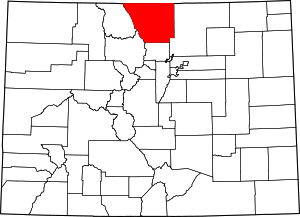Livermore, Colorado
Livermore is an unincorporated community and a U.S. Post Office in Larimer County, Colorado, United States. The Livermore Post Office has the ZIP Code 80536.[2]
Livermore, Colorado | |
|---|---|
Livermore in 2014 | |
 Livermore Location in Colorado  Livermore Location in the United States | |
| Coordinates: 40°47′40″N 105°13′00″W | |
| Country | |
| State | |
| County | Larimer[1] |
| Elevation | 5,896 ft (1,797 m) |
| Time zone | UTC-7 (MST) |
| • Summer (DST) | UTC-6 (MDT) |
| ZIP code[2] | 80536 |
| Area code(s) | 970 |
| GNIS feature ID | 0170174 |
A post office called Livermore has been in operation since 1871.[3] According to tradition, the community's name is an amalgamation of the names of settlers Livernash and Moore.[4]
Geography
Livermore is located at 40°47′40″N 105°13′00″W (40.794319,-105.216579). Livermore's elevation is 5,884.
History
Some 13,000 years ago Paleo-Indians inhabited this region, leaving behind some 79 registered archeological sites. These early Americans continued to occupy this region into historic times. Trappers as well as explorers, including John C. Fremont, followed the South Platte and Cache la Poudre rivers seeking furs and a route through the mountains. The Trapper's Trail was established in 1824-25. The Overland Stage Line to California came through in 1862 paralleling the Cherokee Trail and the Trapper's Trail.
In 1863, a native of Wisconsin, Adolphus Livernash (aged 16) and Stephen Moore built a cabin on the bank of the North Fork of the Cache la Poudre River and engaged in prospecting for coal and precious metals. They were not successful in that endeavor, so neither stayed. Livernash returned to Laporte where he secured employment. In 1874, he married Sara E. Isard, James H. Swan, a Justice of the Peace, performing the ceremony. Later Livernash moved to Boulder County and engaged in mining. He was killed by lightning in 1883, while working in a mine. Moore held on to his claim in Livermore until 1871 when he sold it to Russell Fisk.
Fisk came to the area in 1871, now called Livermore for the names of its earliest permanent settlers, Livernash and Moore, built the first hotel and platted a town on the west bank of the North Fork of the Cache la Poudre River about two miles west of the current intersection of Hwy 287 and Red Feather Lakes Road.
Even though there was a town site that was to be called Livermore, the name 'Livermore' was applied to a much larger area loosely bounded by the Cache la Poudre River to the south, the mountains to the west, the Colorado-Wyoming state line to the north, and the red mesas to the east.
The heart of this place called Livermore was the valley. Homesteaders and stock growers were attracted to the area because of the abundant water and grass, and a thriving ranching community developed. Many of the original homesteads were consolidated into large ranches, some of which persist today. Other ranches have become state wildlife areas and yet others have been divided into smaller acreages for those to enjoy the rural, foothills lifestyle. Livermore was early recognized as the best grazing and stock raising section in Northern Colorado.
The Forks Hotel, built in 1875 by Robert Owen (R.O.) Roberts, was named for its location at the fork in the road bearing west onto the Red Feather Lakes Road from Laramie Hwy (now US Hwy 287). It was built originally as a hotel for the loggers, prospectors, and other travelers who passed through Livermore.
Colorado became a state in 1876 and soon thereafter, a route was sought from the Fort Collins area to enable trade with the upper Poudre Canyon, North Park and all areas in between.
In 1886, gold was discovered in an area called Manhattan, which soon housed a population of 4,000. By 1890, stage stations, hotels and resorts were being built along the way and tourism developed throughout the region.
In 1895, the Colorado General Assembly appropriated $16,000 to construct a road from Bellvue to Livermore and over the Ute Pass to Walden. It was built in 1896-97. This road provided access to timber used for railroad ties during the building of the transcontinental railroad, and later freighters used this route to haul materials for the tunnel construction (Laramie River to Poudre Canyon). Red Feather Lakes road was not only an important route for the Livermore area, but also for the economic development of the region.

In 1985, at the old age of 110, the landmark Forks Hotel caught fire and burned to the ground. Money was raised by the community and it was rebuilt, and its name shortened to simply "The Forks". Today, this thriving wayside establishment provides a place for the many travelers and local residents to rest and relax in the beautiful valley known as Livermore.
References
- "US Board on Geographic Names". United States Geological Survey. 2007-10-25. Retrieved 2008-01-31.
- "ZIP Code Lookup". United States Postal Service. December 28, 2006. Archived from the original (JavaScript/HTML) on January 1, 2008. Retrieved December 28, 2006.
- "Post offices". Jim Forte Postal History. Retrieved 29 June 2016.
- Dawson, John Frank. Place names in Colorado: why 700 communities were so named, 150 of Spanish or Indian origin. Denver, CO: The J. Frank Dawson Publishing Co. p. 32.
- "Livermore Woman's Club". www.livermorewomansclub.org. Retrieved 2019-11-25.
